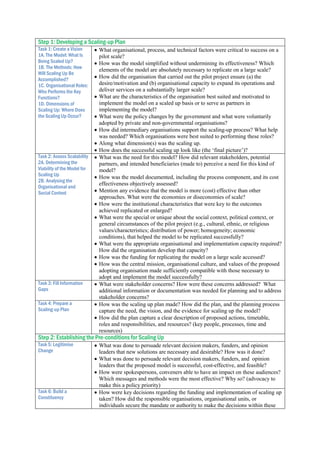
Scaling up process documentation
- 1. Step 1: Developing a Scaling-up Plan Task 1: Create a Vision What organisational, process, and technical factors were critical to success on a 1A. The Model: What Is pilot scale? Being Scaled Up? How was the model simplified without undermining its effectiveness? Which 1B. The Methods: How elements of the model are absolutely necessary to replicate on a large scale? Will Scaling Up Be Accomplished? How did the organisation that carried out the pilot project ensure (a) the 1C. Organisational Roles: desire/motivation and (b) organisational capacity to expand its operations and Who Performs the Key deliver services on a substantially larger scale? Functions? What are the characteristics of the organisation best suited and motivated to 1D. Dimensions of implement the model on a scaled up basis or to serve as partners in Scaling Up: Where Does implementing the model? the Scaling Up Occur? What were the policy changes by the government and what were voluntarily adopted by private and non-governmental organisations? How did intermediary organisations support the scaling-up process? What help was needed? Which organisations were best suited to performing these roles? Along what dimension(s) was the scaling up. How does the successful scaling up look like (the „final picture‟)? Task 2: Assess Scalability What was the need for this model? How did relevant stakeholders, potential 2A. Determining the partners, and intended beneficiaries (made to) perceive a need for this kind of Viability of the Model for model? Scaling Up How was the model documented, including the process component, and its cost 2B. Analysing the effectiveness objectively assessed? Organisational and Social Context Mention any evidence that the model is more (cost) effective than other approaches. What were the economies or diseconomies of scale? How were the institutional characteristics that were key to the outcomes achieved replicated or enlarged? What were the special or unique about the social context, political context, or general circumstances of the pilot project (e.g., cultural, ethnic, or religious values/characteristics; distribution of power; homogeneity; economic conditions), that helped the model to be replicated successfully? What were the appropriate organisational and implementation capacity required? How did the organisation develop that capacity? How was the funding for replicating the model on a large scale accessed? How was the central mission, organisational culture, and values of the proposed adopting organisation made sufficiently compatible with those necessary to adopt and implement the model successfully? Task 3: Fill Information What were stakeholder concerns? How were these concerns addressed? What Gaps additional information or documentation was needed for planning and to address stakeholder concerns? Task 4: Prepare a How was the scaling up plan made? How did the plan, and the planning process Scaling-up Plan capture the need, the vision, and the evidence for scaling up the model? How did the plan capture a clear description of proposed actions, timetable, roles and responsibilities, and resources? (key people, processes, time and resources) Step 2: Establishing the Pre-conditions for Scaling Up Task 5: Legitimise What was done to persuade relevant decision makers, funders, and opinion Change leaders that new solutions are necessary and desirable? How was it done? What was done to persuade relevant decision makers, funders, and opinion leaders that the proposed model is successful, cost-effective, and feasible? How were spokespersons, conveners able to have an impact on these audiences? Which messages and methods were the most effective? Why so? (advocacy to make this a policy priority) Task 6: Build a How were key decisions regarding the funding and implementation of scaling up Constituency taken? How did the responsible organisations, organisational units, or individuals secure the mandate or authority to make the decisions within these
- 2. organisations? How were these decision makers persuaded? What arguments, appeals, or advocacy strategies were employed, and how? How were the most effective networks and alliances for carrying out this advocacy identified? How were they efficiently mobilised and organised? How was buy-in from the leadership and staff of potential implementing organisations achieved? Task 7: Realign and What additional human, institutional, and financial resources were needed to Mobilise Resources support the process of “going to scale”? What was done to ensure that these resources were available? What human, institutional, and financial resources was needed for “operating at scale”? What was done to ensure that these resources were available? What new partnerships needed to be established? How was it done? Step 3: Implementing the Scaling-up Process Task 8: Modify What was done to encourage and assist the originating organisation to relinquish Organisational Structures control and make the other changes necessary for successful transfer and scaling up of the model? How was it done? Where and from whom did the initiative come from and who anchored the process. What changes were made in the “adopting organisation” and how were they made? How was change resistance handled? Who were the natural allies? How was the transfer process handled? What changes were made in their own capacity—structure, staffing, or operations—to do this successfully? Task 9: Coordinate Action How were action plans and budgets made for implementing the scaling-up effort and, what more needs to be done? How were responsibilities allocated and efficient mechanisms established for coordinating the scaling-up effort? Were there any conflicts? Who was responsible for monitoring these efforts and for resolving any conflicts? Task 10: Track What are the procedures for documenting the progress, lessons learned, and Performance and impact of the scaling-up effort? How were they created? Maintain Momentum What are the most effective mechanisms for ensuring that this information is fed back to key stakeholders and to the broader public and that the information is used to make necessary course corrections? How were these systems created and was it simultaneous, add on, supportive...? (systems and protocols) What are the human and financial resources needed? Who was the motivator? (person centric) Who and what are the motivational factors necessary for maintaining momentum? (person, process intensive) What are the lessons learnt